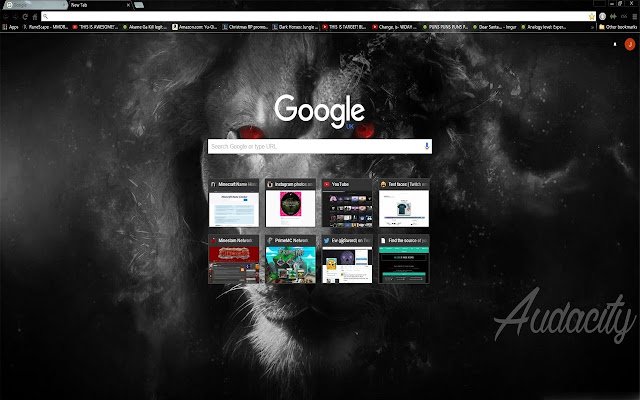Aug 12, 2011 Thanks for the reply. I'm running Audacity 1.3.5-beta (Unicode), and I have 3 availible playback devices. Changing it to any of the 3 still yields no playback (although I can hear streaming audio from the web fine, via my headphones). This is a video demo about the new Audacity online version 2.0.4 implemented in the OffiDocs platform.
Over the course of a term, teachers sometimes identify gaps in their instructional materials. These gaps may be specific outcomes that are not satisfactorily addressed or outcomes that are in need of an alternate delivery mode to enhance engagement and retention. To address these needs instructors, use the tools at their disposal. Instructors are usually well supplied with office applications on their workstations to generate slideshows, worksheets, spreadsheets, and posters. They do their best to cobble together new materials without special applications such as Adobe Photoshop, Adobe Premiere or Articulate Storyline.
Specialized materials development tools are quite expensive. Larger educational institutions may cope by acquiring site licenses for their staff. Mid to smaller sized institutions may not have the necessary budget to purchase these tools. In addition to high price tags, the training required for the average teacher to use these tools effectively can be expensive and time consuming.
Common materials development activities include:
- image editing
- audio editing
- video editing
- illustration
- technical drawing
- text editing
- screen capturing/grabbing
- media file conversion
In some of my jobs, specialized editing tools have been provided by the institutions, while in others I had to find my own solutions. In the latter case, I have been developing learning materials with whatever tools I can find to get the job done. Usually, I use simple tools to complete small jobs such as audio edits, image resizing or a screen capture rather than launch the professional grade tools such as Photoshop. I do this because the specialist tools take time to open and they take large portions of the computer’s memory. For small jobs I use the quick, simple online resource.
This is a list of some free, online tool options available to teachers trying to enhance their instructional materials. There are many more alternatives. Choose the tools that you can use comfortably and arrange them in in a favorites list, an online graphical links resource such as Symbaloo or as icons on your desktop.
Affordable Tool Options
Image editing with Pixlr
https://pixlr.com/editor
Pixlr Editor is an online image editing application with all of the image manipulation features that instructors need to create original images or optimize photographs. I use it in a pinch when launching Photoshop for a minor edit is not practical.
Vector drawing with Vectr
https://vectr.com
Vector images are much smaller than bitmapped images as they store information on exact points, angles, curves, lines and fills of objects instead of storing information on each pixel. When you require a logo or any an illustration Vectr is a useful resource.
Offidocs Audacity Mac
Audio editing with Audacity online
https://www.offidocs.com/create-audacity.html?username=asad
Through the Offidocs platform, Audacity can be used as an online tool. It can be used to record, edit and publish audio files. Audacity is a basic audio editor that can be used for crafting sound files straightaway.

Video editing with Moviemaker online
http://moviemakeronline.com
To edit and refine video to your instructional requirements, Video Moviemaker offers a very unique interface with a myriad of features. This tool is also a cool way to make slide by slide animations.
Technical drawings with DrawIO
https://www.draw.io
Draw.IO offers an extensive series of sets of line vector drawing objects that can be manipulated to form simple to complex technical drawings. These can include flow charts, organization charts, floor plans, electric circuits, technical processes and much more.
Screen capturing with ScreenCast-O-Matic
https://screencast-o-matic.com
To record a process or steps of a software or an app on your workstation with the option of capturing video from your webcam, Screencast-o-matic is a useful tool. Capture lectures, send feedback, create announcements to support blended learning in your classroom.
Text document with Google text editor
https://docs.google.com
If you are in a situation without a word processor, use the Google text editor. You will be able to access the documents produced with your Google account and an internet connection.
Converting media with Online Convert
https://www.online-convert.com
Online Convert changes digital files to meet the requirements of a digital service. A common example of this is converting an audio files from WMA to Mp3 as required by a learning management system. File types include images, video, audio, ebook, archive and document.
Final Thoughts
Using free online tools to develop learning objects makes sense if your institution does not have the budget and training to support the materials developer in you. Since these tools are quickly accessible and do not take a great deal of processor memory, for small jobs they make sense.
There are free and sometimes open applications that can be installed on your workstations such as GIMP as a substitute for Photoshop, but at many institutions workstations are locked down for security and maintenance reasons. From experience I know that IT departments are reticent in adopting and supporting open source solutions.
Offidocs Audacity App
If you use an alternate online tool to accomplish your materials development goals, please comment below to share with this community.
- Improve Communication with Plain Language – 13th April 2021
- Moodle Feedback Activity – Create Customized Surveys & Low Stakes Quizzes – 13th March 2021
- Read Aloud for Reading & Listening Activities – 13th February 2021
